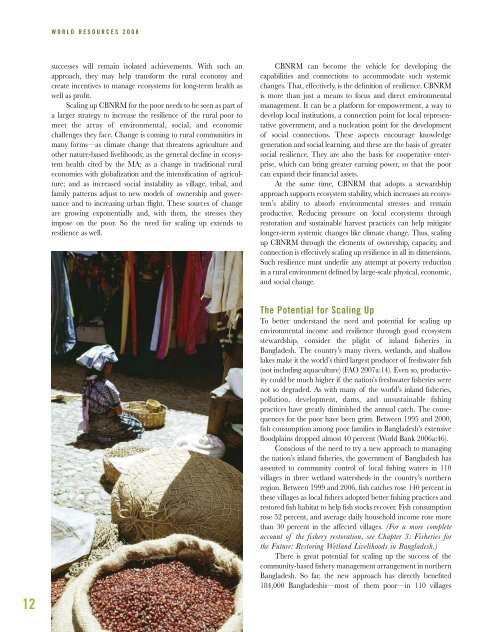Growing the Wealth of the Poor - World Resources Institute
Growing the Wealth of the Poor - World Resources Institute
Growing the Wealth of the Poor - World Resources Institute
You also want an ePaper? Increase the reach of your titles
YUMPU automatically turns print PDFs into web optimized ePapers that Google loves.
W O R L D R E S O U R C E S 2 0 0 8successes will remain isolated achievements. With such anapproach, <strong>the</strong>y may help transform <strong>the</strong> rural economy andcreate incentives to manage ecosystems for long-term health aswell as pr<strong>of</strong>it.Scaling up CBNRM for <strong>the</strong> poor needs to be seen as part <strong>of</strong>a larger strategy to increase <strong>the</strong> resilience <strong>of</strong> <strong>the</strong> rural poor tomeet <strong>the</strong> array <strong>of</strong> environmental, social, and economicchallenges <strong>the</strong>y face. Change is coming to rural communities inmany forms—as climate change that threatens agriculture ando<strong>the</strong>r nature-based livelihoods; as <strong>the</strong> general decline in ecosystemhealth cited by <strong>the</strong> MA; as a change in traditional ruraleconomies with globalization and <strong>the</strong> intensification <strong>of</strong> agriculture;and as increased social instability as village, tribal, andfamily patterns adjust to new models <strong>of</strong> ownership and governanceand to increasing urban flight. These sources <strong>of</strong> changeare growing exponentially and, with <strong>the</strong>m, <strong>the</strong> stresses <strong>the</strong>yimpose on <strong>the</strong> poor. So <strong>the</strong> need for scaling up extends toresilience as well.CBNRM can become <strong>the</strong> vehicle for developing <strong>the</strong>capabilities and connections to accommodate such systemicchanges. That, effectively, is <strong>the</strong> definition <strong>of</strong> resilience. CBNRMis more than just a means to focus and direct environmentalmanagement. It can be a platform for empowerment, a way todevelop local institutions, a connection point for local representativegovernment, and a nucleation point for <strong>the</strong> development<strong>of</strong> social connections. These aspects encourage knowledgegeneration and social learning, and <strong>the</strong>se are <strong>the</strong> basis <strong>of</strong> greatersocial resilience. They are also <strong>the</strong> basis for cooperative enterprise,which can bring greater earning power, so that <strong>the</strong> poorcan expand <strong>the</strong>ir financial assets.At <strong>the</strong> same time, CBNRM that adopts a stewardshipapproach supports ecosystem stability, which increases an ecosystem’sability to absorb environmental stresses and remainproductive. Reducing pressure on local ecosystems throughrestoration and sustainable harvest practices can help mitigatelonger-term systemic changes like climate change. Thus, scalingup CBNRM through <strong>the</strong> elements <strong>of</strong> ownership, capacity, andconnection is effectively scaling up resilience in all its dimensions.Such resilience must underlie any attempt at poverty reductionin a rural environment defined by large-scale physical, economic,and social change.12The Potential for Scaling UpTo better understand <strong>the</strong> need and potential for scaling upenvironmental income and resilience through good ecosystemstewardship, consider <strong>the</strong> plight <strong>of</strong> inland fisheries inBangladesh. The country’s many rivers, wetlands, and shallowlakes make it <strong>the</strong> world’s third largest producer <strong>of</strong> freshwater fish(not including aquaculture) (FAO 2007a:14). Even so, productivitycould be much higher if <strong>the</strong> nation’s freshwater fisheries werenot so degraded. As with many <strong>of</strong> <strong>the</strong> world’s inland fisheries,pollution, development, dams, and unsustainable fishingpractices have greatly diminished <strong>the</strong> annual catch. The consequencesfor <strong>the</strong> poor have been grim. Between 1995 and 2000,fish consumption among poor families in Bangladesh’s extensivefloodplains dropped almost 40 percent (<strong>World</strong> Bank 2006a:46).Conscious <strong>of</strong> <strong>the</strong> need to try a new approach to managing<strong>the</strong> nation’s inland fisheries, <strong>the</strong> government <strong>of</strong> Bangladesh hasassented to community control <strong>of</strong> local fishing waters in 110villages in three wetland watersheds in <strong>the</strong> country’s nor<strong>the</strong>rnregion. Between 1999 and 2006, fish catches rose 140 percent in<strong>the</strong>se villages as local fishers adopted better fishing practices andrestored fish habitat to help fish stocks recover. Fish consumptionrose 52 percent, and average daily household income rose morethan 30 percent in <strong>the</strong> affected villages. (For a more completeaccount <strong>of</strong> <strong>the</strong> fishery restoration, see Chapter 3: Fisheries for<strong>the</strong> Future: Restoring Wetland Livelihoods in Bangladesh.)There is great potential for scaling up <strong>the</strong> success <strong>of</strong> <strong>the</strong>community-based fishery management arrangement in nor<strong>the</strong>rnBangladesh. So far, <strong>the</strong> new approach has directly benefited184,000 Bangladeshis—most <strong>of</strong> <strong>the</strong>m poor—in 110 villages
















